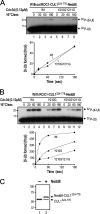The human Cdc34 carboxyl terminus contains a non-covalent ubiquitin binding activity that contributes to SCF-dependent ubiquitination
- PMID: 20353940
- PMCID: PMC2878539
- DOI: 10.1074/jbc.M109.090621
The human Cdc34 carboxyl terminus contains a non-covalent ubiquitin binding activity that contributes to SCF-dependent ubiquitination
Abstract
Cdc34 is an E2 ubiquitin-conjugating enzyme that functions in conjunction with SCF (Skp1.Cullin 1.F-box) E3 ubiquitin ligase to catalyze covalent attachment of polyubiquitin chains to a target protein. Here we identified direct interactions between the human Cdc34 C terminus and ubiquitin using NMR chemical shift perturbation assays. The ubiquitin binding activity was mapped to two separate Cdc34 C-terminal motifs (UBS1 and UBS2) that comprise residues 206-215 and 216-225, respectively. UBS1 and UBS2 bind to ubiquitin in the proximity of ubiquitin Lys(48) and C-terminal tail, both of which are key sites for conjugation. When bound to ubiquitin in one orientation, the Cdc34 UBS1 aromatic residues (Phe(206), Tyr(207), Tyr(210), and Tyr(211)) are probably positioned in the vicinity of ubiquitin C-terminal residue Val(70). Replacement of UBS1 aromatic residues by glycine or of ubiquitin Val(70) by alanine decreased UBS1-ubiquitin affinity interactions. UBS1 appeared to support the function of Cdc34 in vivo because human Cdc34(1-215) but not Cdc34(1-200) was able to complement the growth defect by yeast Cdc34 mutant strain. Finally, reconstituted IkappaBalpha ubiquitination analysis revealed a role for each adjacent pair of UBS1 aromatic residues (Phe(206)/Tyr(207), Tyr(210)/Tyr(211)) in conjugation, with Tyr(210) exhibiting the most pronounced catalytic function. Intriguingly, Cdc34 Tyr(210) was required for the transfer of the donor ubiquitin to a receptor lysine on either IkappaBalpha or a ubiquitin in a manner that depended on the neddylated RING sub-complex of the SCF. Taken together, our results identified a new ubiquitin binding activity within the human Cdc34 C terminus that contributes to SCF-dependent ubiquitination.
Figures







Similar articles
-
Ubiquitin-conjugating enzyme Cdc34 and ubiquitin ligase Skp1-cullin-F-box ligase (SCF) interact through multiple conformations.J Biol Chem. 2015 Jan 9;290(2):1106-18. doi: 10.1074/jbc.M114.615559. Epub 2014 Nov 25. J Biol Chem. 2015. PMID: 25425648 Free PMC article.
-
Identification of a positive regulator of the cell cycle ubiquitin-conjugating enzyme Cdc34 (Ubc3).Mol Cell Biol. 1996 Feb;16(2):677-84. doi: 10.1128/MCB.16.2.677. Mol Cell Biol. 1996. PMID: 8552096 Free PMC article.
-
The acidic tail domain of human Cdc34 is required for p27Kip1 ubiquitination and complementation of a cdc34 temperature sensitive yeast strain.Cell Cycle. 2005 Oct;4(10):1421-7. doi: 10.4161/cc.4.10.2054. Epub 2005 Oct 26. Cell Cycle. 2005. PMID: 16123592
-
Ubiquitin-conjugating enzyme E2C: a potential cancer biomarker.Int J Biochem Cell Biol. 2014 Feb;47:113-7. doi: 10.1016/j.biocel.2013.11.023. Epub 2013 Dec 17. Int J Biochem Cell Biol. 2014. PMID: 24361302 Review.
-
Constructing and decoding unconventional ubiquitin chains.Nat Struct Mol Biol. 2011 May;18(5):520-8. doi: 10.1038/nsmb.2066. Nat Struct Mol Biol. 2011. PMID: 21540891 Review.
Cited by
-
Structural insights into E1 recognition and the ubiquitin-conjugating activity of the E2 enzyme Cdc34.Nat Commun. 2019 Jul 24;10(1):3296. doi: 10.1038/s41467-019-11061-8. Nat Commun. 2019. PMID: 31341161 Free PMC article.
-
Mechanism of polyubiquitination by human anaphase-promoting complex: RING repurposing for ubiquitin chain assembly.Mol Cell. 2014 Oct 23;56(2):246-260. doi: 10.1016/j.molcel.2014.09.009. Epub 2014 Oct 9. Mol Cell. 2014. PMID: 25306923 Free PMC article.
-
E2s: structurally economical and functionally replete.Biochem J. 2011 Jan 1;433(1):31-42. doi: 10.1042/BJ20100985. Biochem J. 2011. PMID: 21158740 Free PMC article. Review.
-
Dss1 is a 26S proteasome ubiquitin receptor.Mol Cell. 2014 Nov 6;56(3):453-461. doi: 10.1016/j.molcel.2014.09.008. Epub 2014 Oct 9. Mol Cell. 2014. PMID: 25306921 Free PMC article.
-
Mechanism of millisecond Lys48-linked poly-ubiquitin chain formation by cullin-RING ligases.Nat Struct Mol Biol. 2024 Feb;31(2):378-389. doi: 10.1038/s41594-023-01206-1. Epub 2024 Feb 7. Nat Struct Mol Biol. 2024. PMID: 38326650 Free PMC article.
References
-
- Hershko A., Ciechanover A. (1998) Annu. Rev. Biochem. 67, 425–479 - PubMed
-
- Pickart C. M. (2004) Cell 116, 181–190 - PubMed
-
- Feldman R. M., Correll C. C., Kaplan K. B., Deshaies R. J. (1997) Cell 91, 221–230 - PubMed
-
- Skowyra D., Craig K. L., Tyers M., Elledge S. J., Harper J. W. (1997) Cell 91, 209–219 - PubMed
-
- Tan P., Fuchs S. Y., Chen A., Wu K., Gomez C., Ronai Z., Pan Z. Q. (1999) Mol. Cell 3, 527–533 - PubMed
Publication types
MeSH terms
Substances
Grants and funding
LinkOut - more resources
Full Text Sources
Molecular Biology Databases
Research Materials

